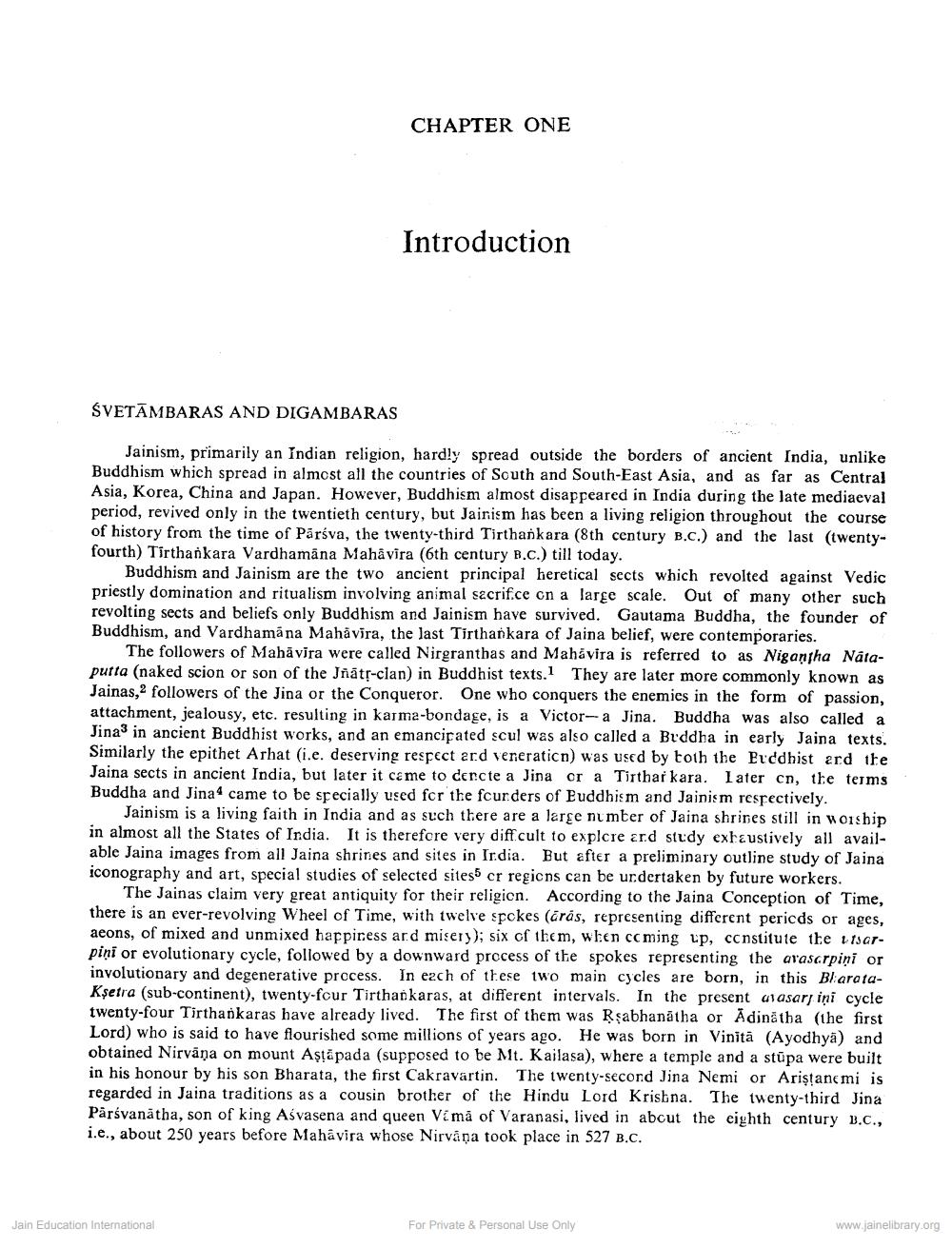________________
CHAPTER ONE
Introduction
SVETĀMBARAS AND DIGAMBARAS
Jainism, primarily an Indian religion, hardly spread outside the borders of ancient India, unlike Buddhism which spread in almost all the countries of South and South-East Asia, and as far as Central Asia, Korea, China and Japan. However, Buddhism almost disappeared in India during the late mediaeval period, revived only in the twentieth century, but Jainism has been a living religion throughout the course of history from the time of Pärśva, the twenty-third Tirthankara (8th century B.C.) and the last (twentyfourth) Tirthankara Vardhamana Mahavira (6th century B.C.) till today.
Buddhism and Jainism are the two ancient principal heretical sects which revolted against Vedic priestly domination and ritualism involving animal sacrifice on a large scale. Out of many other such revolting sects and beliefs only Buddhism and Jainism have survived. Gautama Buddha, the founder of Buddhism, and Vardhamana Mahavira, the last Tirthankara of Jaina belief, were contemporaries.
Jain Education International
The followers of Mahavira were called Nirgranthas and Mahavira is referred to as Nigantha Nataputta (naked scion or son of the Jñatṛ-clan) in Buddhist texts. They are later more commonly known as Jainas, followers of the Jina or the Conqueror. One who conquers the enemies in the form of passion, attachment, jealousy, etc. resulting in karma-bondage, is a Victor-a Jina. Buddha was also called a Jina3 in ancient Buddhist works, and an emancipated scul was also called a Buddha in early Jaina texts. Similarly the epithet Arhat (i.e. deserving respect and veneration) was used by both the Buddhist and the Jaina sects in ancient India, but later it came to dercte a Jina or a Tirthar kara. Later cn, the terms Buddha and Jina came to be specially used for the founders of Euddhism and Jainism respectively.
Jainism is a living faith in India and as such there are a large number of Jaina shrines still in worship in almost all the States of India. It is therefore very difficult to explore and study exhaustively all available Jaina images from all Jaina shrines and sites in India. But after a preliminary outline study of Jaina iconography and art, special studies of selected sites5 cr regions can be undertaken by future workers.
The Jainas claim very great antiquity for their religion. According to the Jaina Conception of Time, there is an ever-revolving Wheel of Time, with twelve spokes (arás, representing different pericds or ages, aeons, of mixed and unmixed happiness ard misery); six of them, when ccming up, ccnstitute the tsarpini or evolutionary cycle, followed by a downward process of the spokes representing the avasarpini or involutionary and degenerative process. In each of these two main cycles are born, in this BarataKşetra (sub-continent), twenty-four Tirthankaras, at different intervals. In the present avasari ini cycle twenty-four Tirthankaras have already lived. The first of them was Ṛsabhanatha or Adinatha (the first Lord) who is said to have flourished some millions of years ago. He was born in Vinita (Ayodhya) and obtained Nirvana on mount Aṣṭāpada (supposed to be Mt. Kailasa), where a temple and a stupa were built in his honour by his son Bharata, the first Cakravartin. The twenty-second Jina Nemi or Aristanemi is regarded in Jaina traditions as a cousin brother of the Hindu Lord Krishna. The twenty-third Jina Pärsvanatha, son of king Asvasena and queen Vima of Varanasi, lived in abcut the eighth century B.C., i.e., about 250 years before Mahavira whose Nirvana took place in 527 B.C.
For Private & Personal Use Only
www.jainelibrary.org




